
I, Robot is a fixup novel of science fiction short stories or essays by American writer Isaac Asimov. The stories originally appeared in the American magazines Super Science Stories and Astounding Science Fiction between 1940 and 1950 and were then compiled into a book for stand-alone publication by Gnome Press in 1950, in an initial edition of 5,000 copies. The stories are woven together by a framing narrative in which the fictional Dr. Susan Calvin tells each story to a reporter in the 21st century. Although the stories can be read separately, they share a theme of the interaction of humans, robots, and morality, and when combined they tell a larger story of Asimov's fictional history of robotics.
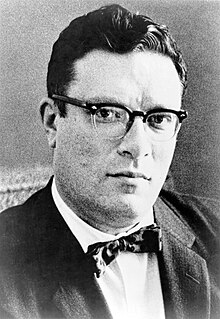
Isaac Asimov was an American writer and professor of biochemistry at Boston University. During his lifetime, Asimov was considered one of the "Big Three" science fiction writers, along with Robert A. Heinlein and Arthur C. Clarke. A prolific writer, he wrote or edited more than 500 books. He also wrote an estimated 90,000 letters and postcards. Best known for his hard science fiction, Asimov also wrote mysteries and fantasy, as well as much nonfiction.

The Robot series is a series of 37 science fiction short stories and six novels by American writer Isaac Asimov, featuring positronic robots.

Janet Opal Asimov, usually written as J. O. Jeppson, was an American science fiction writer, psychiatrist, and psychoanalyst.

Gardner Raymond Dozois was an American science fiction author and editor. He was the founding editor of The Year's Best Science Fiction anthologies (1984–2018) and was editor of Asimov's Science Fiction magazine (1984–2004), garnering multiple Hugo and Locus Awards for those works almost every year. He also won the Nebula Award for Best Short Story twice. He was inducted to the Science Fiction Hall of Fame on June 25, 2011.
This is a bibliography of the books written or edited by Isaac Asimov, arranged alphabetically. Asimov was a prolific author, and he engaged in many collaborations with other authors. This list may not yet be complete. The total number of books listed here is over 500. Asimov died in 1992 at age 72; a small number of his books were published posthumously.

"Nightfall" is a 1941 science fiction short story by the American writer Isaac Asimov about the coming of darkness to the people of a planet ordinarily illuminated by sunlight at all times. It was adapted into a novel with Robert Silverberg in 1990. The short story has been included in 48 anthologies and has appeared in six collections of Asimov's stories. In 1968, the Science Fiction Writers of America voted "Nightfall" the best science fiction short story written prior to the 1965 establishment of the Nebula Awards and included it in The Science Fiction Hall of Fame Volume One, 1929–1964.

Nightfall and Other Stories (1969) is a collection of 20 previously published science fiction short stories by Isaac Asimov. Asimov added a brief introduction to each story, explaining some aspect of the story's history and/or how it came to be written.
The first Golden Age of Science Fiction, often recognized in the United States as the period from 1938 to 1946, was an era during which the science fiction genre gained wide public attention and many classic science fiction stories were published. In the history of science fiction, the Golden Age follows the "pulp era" of the 1920s and 1930s, and precedes New Wave science fiction of the 1960s and 1970s. The 1950s are a transitional period in this scheme; however, Robert Silverberg, who came of age in the 1950s, saw that decade as the true Golden Age.
Martin Harry Greenberg was an American academic and anthologist in many genres, including mysteries and horror, but especially in speculative fiction. In all, he compiled 1,298 anthologies and commissioned over 8,200 original short stories. He founded Tekno Books, a packager of more than 2000 published books. He was also a co-founder of the Sci-Fi Channel. Greenberg was also an expert in terrorism and the Middle East. He was a longtime friend, colleague and business partner of Isaac Asimov.

Before the Golden Age: A Science Fiction Anthology of the 1930s is an anthology of 25 science fiction stories from 1930s pulp magazines, edited by American science fiction writer Isaac Asimov. It also includes "Big Game", a short story written by Asimov in 1941 and never sold. The anthology was first published in April 1974, and won the 1975 Locus Award for Best reprint anthology.
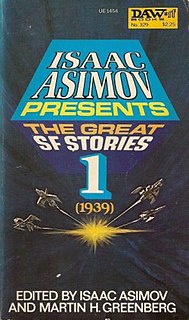
Isaac Asimov Presents The Great SF Stories 1 (1939) is an American collection of short stories, edited by Isaac Asimov and Martin H. Greenberg, originally published by DAW books in March 1979. It contains science fiction stories selected by the editors that were published in the year 1939. The book is part of a 25 volume series. Each successive volume in the series contains stories from the next year, continuing through 1963. The series starts with 1939 because Asimov had previously published a three volume anthology series titled, "Before the Golden Age", covering years 1931 - 1938, which he considered to be definitive for those years. According to DAW, The Great SF Stories 1 (1939) "is the first in what Isaac Asimov plans to be a definitive series of sf anthologies, covering year by year the truly memorable stories that have progressively brought science fiction to its present prominence". The second volume of the series is Isaac Asimov Presents The Great SF Stories 2 (1940).
Michael Joseph Cassutt is an American television producer, screenwriter, and author. His notable TV work includes producing or writing, or both, for The Outer Limits, Eerie, Indiana, Beverly Hills, 90210, and The Twilight Zone. In addition to his work in television, Cassutt has written over thirty short stories, predominately in the genres of science fiction and fantasy. He has also published novels, including the 1986 The Star Country, the 1991 Dragon Season, the 2001 Red Moon and the 2011 Heaven's Shadow, in collaboration with David S. Goyer. In addition, Cassutt contributes non-fiction articles to magazines and is the author of the non-fiction book, The Astronaut Maker, a biography of NASA legend George W. S. Abbey (2018).
In a writing career spanning 53 years (1939–1992), science fiction and popular science author Isaac Asimov (1920–1992) wrote and published 40 novels, 383 short stories, over 280 non-fiction books, and edited about 147 others.
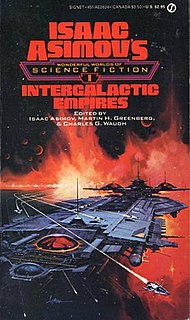
Isaac Asimov's Wonderful Worlds of Science Fiction is a series of ten themed paperback science fiction anthologies edited by Isaac Asimov, Martin H. Greenberg and Charles G. Waugh, a companion set to the twelve volume Isaac Asimov's Magical Worlds of Fantasy, produced by the same editors. It was published by Signet/New American Library from 1983 to 1990.
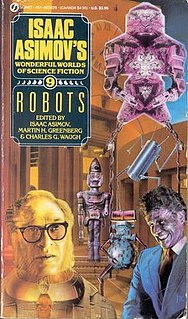
Robots is an anthology of science fiction short stories edited by Isaac Asimov, Martin H. Greenberg and Charles G. Waugh as the ninth volume in their Isaac Asimov's Wonderful Worlds of Science Fiction series. It was first published in paperback by Signet/New American Library in April 1989. The first British edition was issued in paperback by Robinson in 1989.
Isaac Asimov wrote three volumes of autobiography. In Memory Yet Green (1979) and In Joy Still Felt (1980) were a two-volume work, covering his life up to 1978. The third volume, I. Asimov: A Memoir (1994), published after his death, was not a sequel but a new work which covered his whole life. This third book won a Hugo Award.

The Mammoth Book of Golden Age Science Fiction: Short Novels of the 1940s is a themed anthology of science fiction short works edited by Isaac Asimov, Martin H. Greenberg, and Charles G. Waugh, the second in a series of six samplers of the field from the 1930s through the 1980s. It was first published in trade paperback by Robinson in 1989, and reissued in 2007. The first American edition was published in hardcover and trade paperback by Carroll & Graf, also in 1989; a second trade paperback edition appeared in 2007. In 1991 Galahad Books issued two hardcover editions under the variant titles Great Tales of the Golden Age of Science Fiction and Science Fiction: Classic Stories from the Golden Age of Science Fiction; under the latter title it reissued the book in August 2000, April 2004 and March 2010.
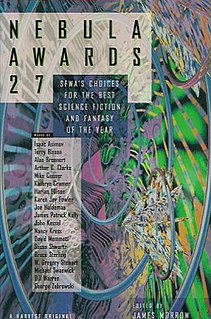
Nebula Awards 27 is an anthology of science fiction short works edited by James Morrow, the second of three successive volumes under his editorship. It was first published in hardcover and trade paperback by Harcourt Brace in April 1993.
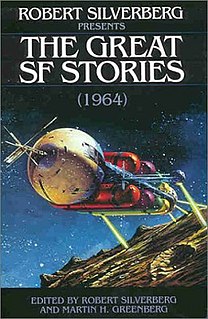
Robert Silverberg Presents the Great SF Stories: 1964 is an American anthology of short stories, edited by Robert Silverberg and Martin H. Greenberg, first published in hardcover by NESFA Press in December 2001. It is a continuation of the Isaac Asimov Presents The Great SF Stories series of short story anthologies, which attempts to list the great science fiction stories from the Golden Age of Science Fiction. This book is a continuation of the book series The Great SF Stories originally edited by Isaac Asimov and Martin H. Greenberg with the last one published in 1992.














